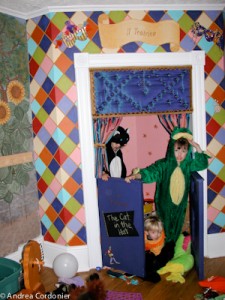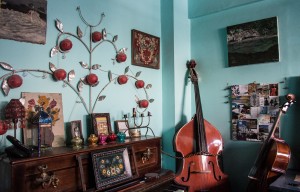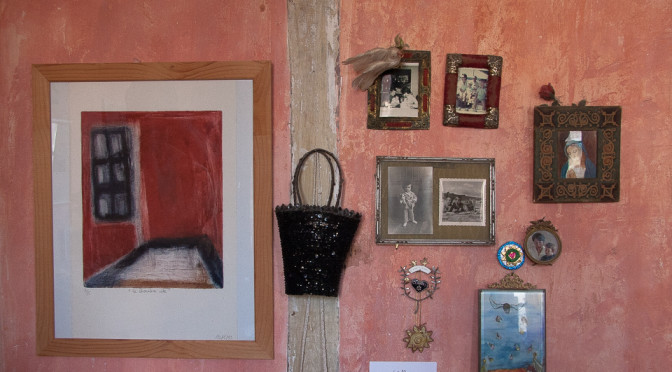I spent the last two days hanging bits and bobs on my dining room walls. And taking most of them down.
Seems the thrill of decorating – the implementation vs. the idea of it – is less a thrill and more a sucker-punch to the head. It appears to involve a disproportionate amount of mental anguish and mind games for a seemingly lightweight activity performed by women who carry purses that match their shoes. It’s not rocket science. So, really, why are my walls still empty?
We’ve lived in our old house for fourteen years now and there is little – save for a couple of mirrors – hanging on the walls. The artwork and trinkets I’ve collected sit in boxes and bins in the basement, tucked in the back of closets, or hidden behind the sofa. I have a few theories about this.
My first theory is that it’s distinctly dissatisfying to hang lovely objects on imperfect surfaces. I can’t remember a time when I wasn’t unhappy with most of the walls: I hated the vinyl wallpaper or I had to make repairs to the lathe and plaster, or the colour didn’t work, or the existing drywall sat proud of the tin ceiling, or I was adding (or removing) walls. Three colour changes and multi-repairs later, the dining room walls – like most of the others in the house – are now finished. This should no longer be an impediment moving forward.
My second theory is that I don’t hang anything on my walls because hanging things would mean I am staying put. No running off overseas, no moving across the country, no doing the life-changing stuff that is still on my agenda. I discuss this with my friend, Lulu, because we are cut from the same cloth. She broke down and bought a bookcase last year and I can only recall the lovely landscape that hangs over her kitchen table. Perched to fly – should the opportunity present itself – yet still here (I’m selfishly glad). And our family is still here in body, if not always in mind. So is that really it?

My third theory has to do with timing. So many of the rooms were repeatedly repurposed throughout our early family years that the furniture seemed to migrate of its own free will. We swapped the kitchen and dining room back where they belonged. Kids shared, switched, and unshared bedrooms. The hand-painted murals and closet-cum-puppet theatre were lovingly created but are now gone. The laundry room moved to the back of the house. We have a front vestibule where there was none. Doorways appeared and I don’t recognize the noisy room any more.
With so much change, it’s little wonder hanging things on walls has been a low priority.
My fourth theory is that I am pulled by my need for individual expression and pushed by the elephant of conformity and fear of making mistakes. I am normally fearless, direct, and creative, yet I am reduced to a neurotic cube of jell-o when I try to hang pictures on my walls. What is ‘right’? Will it be tacky? Will I blow money on framing/fabric/furniture and still make the wrong choice? Will I hate it after a month? Think I’m out of my mind? Check out the piece I wrote on F. Stuart Chapin’s Living Room Status Scale.
Failing to acknowledge the underlying psychology and feelings doesn’t make them go away. I think there’s a reason the whole minimalism thing is so big right now, shepherded under the environmental umbrella: there’s a narrower, highly-prescribed range of objects to choose from, therefore a proportionately smaller chance of self-embarrassment by bad taste or complete lack of any personal style. Look objectively at the design mags and you’ll notice a tedious sameness to many of the wall, floor and furniture treatments. What’s worse, marketing departments gleefully prey on this shift, this human vulnerability, convincing consumers to give up what they already have and buy/make all new stuff. Writer Steven Kurutz sharply captures this trend in his recent NY Times article on living an over-propped life.
I think there’s an awful lot of reality underlying this theory, more than anyone cares to admit.
Which parlays into my fifth, and final, theory. Cohesive decorating and design, with a semblance of originality, is actually hard, highly time-intensive and often expensive. It begins with great promise and excitement and can end in disappointment and self-doubt. Shelter magazines, reality and DIY television shows, blogs, and Pinterest make it look easy because they have crews and budget and professional expertise, and/or they can edit out the mistakes and invent a suitable narrative. And this narrative resembles reality like I resemble Marilyn Monroe: we’re bottle blondes of the female persuasion and that’s it. I know that design and decorating is hard because I have fourteen years of personal anecdotal evidence – and the scars – to prove it.
So what’s a woman staring at blank walls to do? I could go out and buy a whack of stuff that perfectly matches the dimensions and colour schemes of the rooms. I could admit I have a problem, get over seeing design as frivolous, and consult a designer and/or decorator to help move along the process. Or I could ease up on those hammers, Jed, and take it slow: slowly frame my pieces; slowly lay out those things I love on slow winter nights; slowly cull, dream some more, and look around. Maybe I could stop thinking about it all together and do distinctly un-house stuff for awhile.
One day, in who knows how long, I will wake up and realize my house is as done as it’s ever going to be and decide that it makes me happy. And that will be – really – good enough for me.


2 responses to “Staring At Blank Walls”
“My first theory is that it’s distinctly dissatisfying to hang lovely objects on imperfect surfaces.”
It’s the opposite for me. We live in a rental apt. full of quirks and charm, but with some less appealling charms as well. Our walls are so marked up with the shadows of previous tenants’ things, carpets marked with weird stains, much awfulness, that if I hadn’t been one already, I would have had to become a maximalist by necessity in order to cover up the problems and also to make this much lived-in space truly *ours*.
Ha! I would have liked to see ‘before’ photos of the walls – the shadows would be both disturbing and fascinating. How long does someone have to live in a place to ‘grow’ shadows of their decorations? Maybe they were smokers? Or perhaps their stuff just vaporized? Maybe previous tenants – including hard-to-remove blood stains – were the real reason tapestries were hung on castle walls…..
ps. my apologies for not releasing your comment sooner; it didn’t pop into my in basket, like comments usual do.